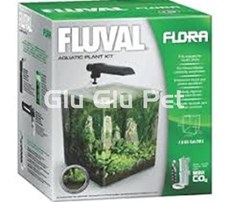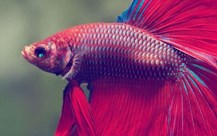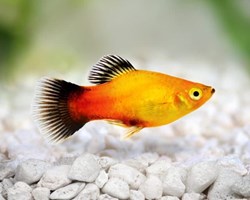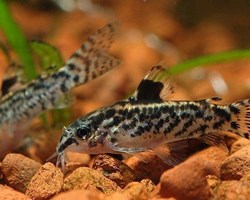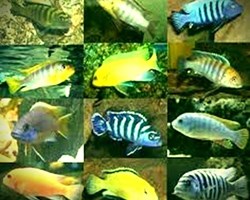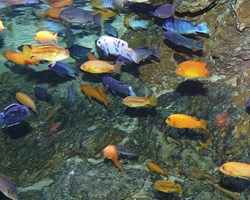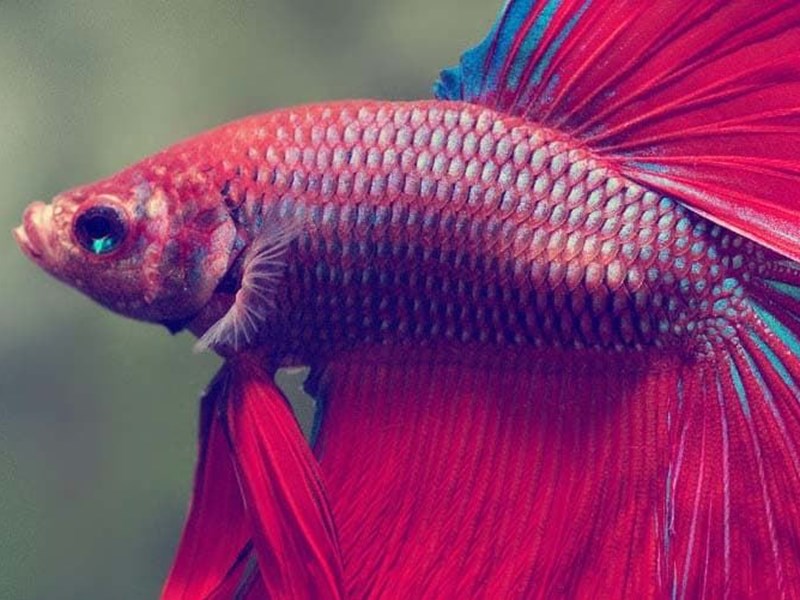
Betta are beautiful fish with different tail shapes that make them really fascinating.
They can be in the shape of a comb, crown, half moon, half sun, delta, double feather, pink, round, veil, etc.
Betta fish are easy to care for and just about anyone could do it by changing their water and feeding them regularly.
But these fish need something else to live happy and healthy.
You must bear in mind that despite their calm nature, they are quite aggressive fish.
In Glu Glu Pet you will see that they are in small cubicles, which seem to be to protect them from the other fish, but in reality they are to protect the other fish from them.
They are very territorial and that is where the name Siam Fighter comes from, and in the case of male bettas they can attack other fish of the same species causing serious injuries and even death.
The females of this species can live together, and the males can coexist with fish of other species without problem.
Males can be easily distinguished from females, as males are larger, their colors are brighter, and their fins are more ornate.
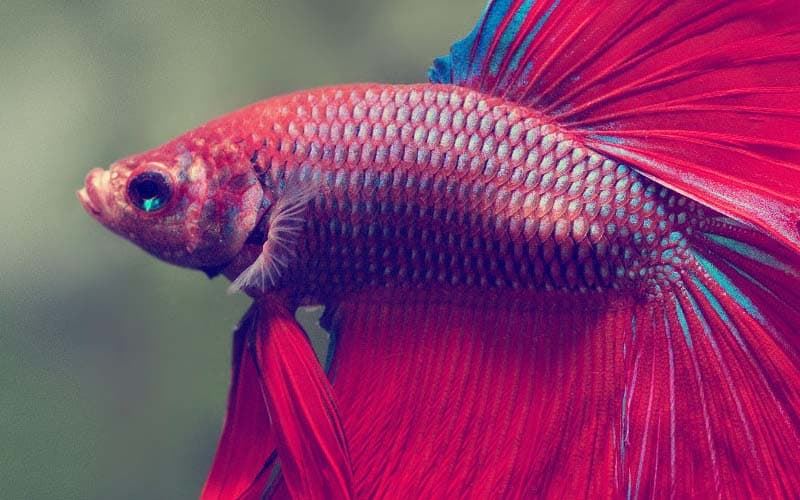
CHARACTERISTICS OF THE BETTA FISH HABITAT:
In their natural habitat they are omnivores, they eat all kinds of insects that are within their reach such as flies, grasshoppers, crickets or the larvae of any insect that they can find on the surface of the water.
In their habitat they have dull brown or green colors, and they are more showy with smaller fins.
The betta fish that we know from aquariums has undergone several crosses to achieve such a spectacular result in colors, tail shapes and sizes.
They have a special organ called a labyrinth that allows them to breathe air from the surface.
This labyrinthine organ is due to the fact that in their habitat they can find waters with little oxygen content such as shallower rice fields, and they could even live in stagnant or polluted waters.
THE BEST SUPPLEMENTS FOR THE BETTA FISH:
For the daily care of our aquarium we may need different accessories and complements that help us achieve the perfect environment for our fish.
A betta fish can live up to three years with good care.
Some tips to achieve a happy environment for betta fish are:
- It should be in a wide space, with at least 24 square inches of water for each inch of fish.
- The water pump and filter are quiet and keep the water clean and flowing constantly.
- The water should be at a temperature between 22 and 27 degrees Celsius.
- Place an air pump to keep the water with oxygen and a thermometer to control the temperature.
- It is important that the fish can explore, so you must put plants, rocks and different objects so that it can do so.
- You must provide a place for it to hide, since although they like to swim, they love to be among the foliage of the aquarium, and that is where they will spend more time.
- Place your aquarium away from the television and out of direct sunlight.
- They must be in a quiet area.
- Try not to scare the fish with sudden changes in lighting or noise.
- Feed them at least once a day and with proper food.
- Regularly clean the aquarium.
- Make sure you always use an aquarium with a lid as these fish jump and can fall out of the tank without you knowing.
TYPES OF BETTA FINS, ABBREVIATIONS ACCORDING TO THE LENGTH AND VARIATION OF THE FINS:
- HM: Or Halfmoon, we usually mean a betta with long fins and 180 degree opening. This leads to confusion as it should be called a long-finned halfmoon, to distinguish it from the short-tailed halfmoon.
- HMPK: Or Halfmoon Plakat. This is the short-tailed halfmoon, that is, a short-finned betta whose tail fin opens at least 180 degrees.
- PK: Or Plakat, from the Thai Pla Kat or Fighting Fish. We refer in Europe and the US to a short-finned fish. However, in Thailand a Plakat is any betta, for example Plakat Cheen they call a long-finned betta.
- DT: Or Double Tail, in Spanish Double Cola. They are bettas whose caudal fin is divided into two lobes. These bettas naturally have an exceptional opening in their caudal fin and are used to provide greater amplitude to the HM, both long tail and short.
- DTPK: Or Double Tail Plakat, in Spanish Double Tail of short tail.
- CT: Or Crowntail, in Spanish Corona. CT bettas or crowntail bettas have fins whose rays protrude from the membranes.
- CTPK: Or Crowntail Plakat, in Spanish Crown of short tail. Exactly the same, but in short tail. These CTPK bettas are the punks of the betta world.
- VT: Or Veil, in Spanish Velo. They are one of the classics in bettas, with many years of history in selective breeding and precursors to our current bettas. They are characterized as the shortest-opening long-tailed betta, just as the PK is also the shortest-opening short-tailed betta.
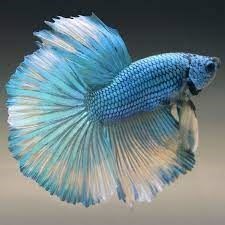
HM: Halfmoon Butterfly.
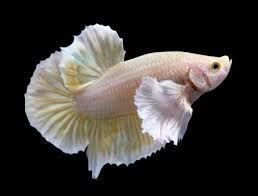
Betta Dumbo Halfmoon.
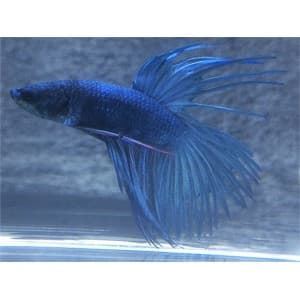
Crown tailed betta.
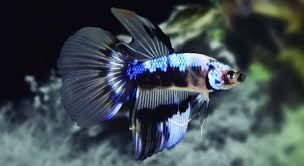
Double tail betta.
ABBREVIATIONS ACCORDING TO THE OPENING OF THE CAUDAL FIN:
- HM: 180º: Halfmoon or Half Moon.
- OHM: >180º: Over Halfmoon or Superior to Media Luna.
- SD: <180º: Super Delta.
- D: Delta.
OPENING OF THE CAUDAL FIN OF THE BETTA SPLENDENS:
One of the most important variables by which the quality of a betta is measured is the opening of its tail fin (in degrees).
If it reaches 180 degrees, the fish is considered to be a Halfmoon and is represented by the initials "HM".
If it opens less it will be super delta or delta (represented as «SD» and «D») and if it opens more than 180 degrees, it will be considered an Over Halfmoon specimen, it is represented with the acronym «OHM» .
Being OHM doesn't necessarily mean higher scoring in a betta contest, but both are higher quality than a super delta or delta.
A betta's perfect fin outlines a beautiful "D" shaped silhouette.
THE FINS OF THE BETTA SPLENDENS:
The first classification we can make is between long tail and short tail.
- Long tail: Long tails are those that exceed half the length of the fish's body.
- Short tail: These are typical of wild species and plakat and approximately 1/3 of the body of the fish.
THE SKIN OF THE BETTA:
Betta skin is divided into 4 overlapping layers: Xanthophora, Erytrophora, Melanophora, and Iridiophora.
- Xanthophore layer: it is in the deepest part and controls the yellow color.
- Erytrófora layer: the next layer above, this is responsible for controlling the red color.
- Melanophoric layer: controls the melanin pigments in the next layer of skin.
- Iridiophore layer: the most superficial layer. It is in charge of blues, greens and iridescence.
BETTA FISH NUTRITION:
The betta fish must be fed with a routine based on granulated feed and that we will complement with live food 2 or 3 times a week.
Try not to feed it with scales and reduce the intake of frozen food and live food such as: Artemia, grinal, daphnia.
The breeding tank where the little bettas are born should be full of infusoria.
We achieve this in the preparation process, leaving the aquarium with plants and snails.
The paramecia and other microscopic organisms that make up the infusoria will be the food for the first two days.
Up to 15 days, the fry should be kept on a diet of artemia and oat microworms in a ratio of 3 to 1, respectively.
Every three times you feed brine shrimp, give them a shot of microworm from oats.
We recommend that you have a low-maintenance back-up crop such as vinegar eel, in case a main food fails you.
After two weeks they should be able to eat microgranulated feed and experience a growth spurt as a result.
It will be difficult for them to eat it as they are used to movement, you can leave them without eating for a day to force them to look for new food sources.
And finally, after a month they should be able to eat adult food and maintain a live food routine only 2 or 3 times a week.
THE BREEDING METHOD:
Selection of specimens:
Always choose a pair of healthy bettas and, without going into genetics, always try to choose the most similar specimens.
Preparation of the specimens:
Once the specimens have been selected for our spawning, the first step is to isolate both and prevent either of them from seeing another fish for 15 days, the female's ovulation period.
Feed them well:
The feeding regimen during the preparation process should be double that of the usual routine.
We will feed in the morning and in the afternoon, interspersing live food such as brine shrimp and grindal.
You will save time if you separate the male from the beginning at the place where you will lay.
Aquarium Preparation:
The breeding aquarium should be ready from the first day and keep cycling and generating infusoria during the 15 days of preparation.
To do this, just put a few floating plants and snails.
The water level will be between 10 and 15 cm. to facilitate the collection of eggs.
The water must be at 28 degrees.
Provides the structure for the nest:
Provide the male with some kind of structure to build his nest under.
The ideal is to use a glass of isothermal material split in half, but you can use any floating object, bubble wrap, catappa leaves, floating plants.
Try to keep it clean and float well.
After 15 days, introduce the male into the breeding aquarium and wait between one and two hours to introduce the female, so that she empowers the place and proclaims herself "King of the aquarium".
If you have already separated it in the breeding tank, you can now put the female.
Releasing the female:
The next day, if the male has a nest and only if he has a nest, we can release the female.
It is possible that the male chases her and bites her, being able to cause moderate injuries to the female, although this is normal.
At that time we should leave them alone and not disturb them, as we could stress the male and lose the clutch.
Throughout the day they should mate, but if this is not the case, we will wait another day and the spawning should take place.
If after this day they do not mate, you will have to empty the aquarium, fill it with clean water and try again another 2 days.
If after this period they do not mate, it may be because something happens to one of them (illness or stress) or simply the ideal conditions for mating have not been provided, in this case they separate and the preparation of 15 days.
It must also be said that not all fish are the same and some breed better than others.
Separating the female:
Once the process is finished, we will know that mating has occurred by the behavior of the couple.
If spawning has occurred, the male will be under the nest manipulating the bubbles and will have stopped trying to attract the female, she, however, will be at the other end of the urn trying to hide.
If the male continues trying to attract her to the nest, mating has not yet occurred and there is no clutch.
When we have already laid, we take out the female being careful not to spoil the nest, we leave her in her bettera and we will feed her well.
The three critical days:
The male should stay looking after the young for 2 or 3 days until we observe that the larvae swim horizontally, time to take the male to his bettera and feed him properly.
This is the most critical process of all and is where beginners most often fail simply by not preparing the specimens well.
15 days apart and good food, ESSENTIAL.
More related articles:
- Specific care for betta fish or Siamese fighters.
- The fighting or fighting fish of Siam; Betta Splendens.
Glu Glu Pet products that may interest you:
- Frozen brine shrimp 20x5g.
- AZOO BETTA PRO 60ml.
- AZOO PREMIUM RED LARVA 130ml.
- Cyclops special Bettas - color intensifier.
- red larva.
- tetra betta.
- Anubia Barteri var. potted lullaby
- Anubia Nana in pot.
- Cryptocoryne Undulatus Green.
- BLAU KIT CUBIC 42.
- HAGEN NANO AQUARIUM FLUVAL FLORA 30L.
- Furniture / table for 20l NANO AQUA-LED Crystal aquariums (ICA).
- Cabinet / table for 30l NANO AQUA-LED Crystal aquariums (ICA).
- ICA NANO AQUALED AQUARIUM 30LTS.
- ICA NANO AQUALED 20 Lts.
- Cascade filter: Aquaclear 20 (HAGEN).
- Cascade filter: Aquaclear 30 (HAGEN).
- Cascade filter: Aquael Versamax 1.
- Cascade filter: Sea Star HX-004.
- Internal filter: EHEIM PICK UP 45.
- Internal filter: FLUVAL NANO FILTER (HAGEN).
- Internal filter: MARINA i25 (HAGEN).
- Internal filter: HYDRA 20 (ICA).
- Internal filter: HYDRA 30 (ICA).
- Internal filter: HYDRA NANO (ICA).
- Internal filter: Micro filter 160L/H ICA.
- Breeding filter: AZOO BIO FILTER SPONGE FILTER.
- Breeding filter: SPONGE FILTER FOR BREEDING.
- Filter material: Aquaclear 20 carbon.
- Filter material: Aquaclear 20 foam.
- Filter material: Aquaclear 30 carbon.
- Filter material: Aquaclear 30 foam.
- Filter material: MULTI-POROUS CERAMIC CUBES (ICA).
- Filter material: Activated carbon 1kg.
- Filter material: Activated carbon in a 45g mesh bag.
- NIROX activated carbon.
- i110/i160 marine cartridge.
- i25 marine cartridge.
- Marina slim filter bio clear cartridge / S10-S15-S20.
- EHEIM replacement Aquaball Biopower.
- EHEIM SUBSTRATE PRO 180g.
- EHEIM SUBSTRAT PRO 720g.
- EHEIM TORF PELLETS.
- FLUVAL ZEO-CARBON.
- FINE FOAMEX REFILL FLUVAL NANO.
- Foamex Fluval U1.
- Foamex Jet Flo 50.
- FOAMEX REFILL FLUVAL NANO.
- PRODAC PERLON.
- Zeo Carbon Elite Jet Flo 50.
- SEA-STAR THERMOHEATER 25W-300W.
- Tetratec HT heater.
- Magicterm heaters 25-300W (PRODAC).
- JAGER THERMOHEATERS 25W-300W (EHEIM).
- JBL THERMOMETER MINI.
- MINERVA LARGE ADHESIVE LIQUID CRYSTAL THERMOMETER (HAGEN).
- MARINE GLASS THERMOMETER WITH SUCTION CUP.
- PRODAC small adhesive digital thermometer.
- INDOOR DIGITAL THERMOMETER WITH SUCTION CUP.
- FLUVAL NANO THERMOMETER (HAGEN).
